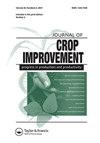Resistance to Pythium root rot and anthracnose among Kenyan common bean genotypes and marker-assisted introgression of resistance genes
IF 1.5
Q3 AGRONOMY
引用次数: 0
Abstract
ABSTRACT Common bean (Phaseolus vulgaris L.) is an important food legume crop and major protein source in Kenya and many parts of the world. However, the yields are low due to the diseases like anthracnose caused by Colletotrichum lindemunthianum and Pythium root rots. The study, therefore, sought to screen Kenyan common bean genotypes for anthracnose and Pythium resistance and to improve the resistance of local landraces to the two diseases. Local landraces and commercial cultivars were screened for resistance under greenhouse conditions for Pythium and in vitro for anthracnose. The results showed that majority of the landraces were moderately resistant to anthracnose and Pythium root rot. The study further utilized molecular markers linked to anthracnose and Pythium resistance, respectively, to determine their potential to detect specific resistance genes among the test genotypes. None of the markers amplified the test genotypes except the control genotypes pointing toward different resistance genes. Further, cultivars G2333 and KK8 were used as donor parents for anthracnose and Pythium resistance, respectively, in a marker-assisted backcross breeding program involving three high-yielding farmer-preferred landraces. A number of lines were developed that carry both resistance genes. These lines can be advanced for release as new cultivars to enhance common bean production in Kenya.肯尼亚普通大豆基因型对腐霉根腐病和炭疽病的抗性及抗性基因的标记辅助导入
菜豆(Phaseolus vulgaris L.)是肯尼亚和世界许多地区重要的食用豆类作物和主要蛋白质来源。然而,由于炭疽病和腐霉根腐病引起的炭疽病,产量较低。因此,这项研究试图筛选肯尼亚普通豆类的炭疽病和腐霉抗性基因型,并提高当地地方品种对这两种疾病的抗性。在温室条件下和在体外筛选地方品种和商业品种对腐霉的抗性。结果表明,大多数地方品种对炭疽病和腐霉根腐病具有中度抗性。本研究进一步利用分别与炭疽病和腐败病抗性相关的分子标记,确定了它们在检测基因型中检测特定抗性基因的潜力。除了指向不同抗性基因的对照基因型外,没有任何标记扩增测试基因型。此外,在涉及三个高产农民偏好的地方品种的标记辅助回交育种计划中,品种G2333和KK8分别被用作炭疽病和腐霉抗性的供体亲本。已经开发出许多携带这两种抗性基因的品系。这些品系可以作为新品种提前发布,以提高肯尼亚的普通大豆产量。
本文章由计算机程序翻译,如有差异,请以英文原文为准。
求助全文
约1分钟内获得全文
求助全文
来源期刊

Journal of Crop Improvement
Multiple-
CiteScore
3.30
自引率
7.70%
发文量
42
期刊介绍:
Journal of Crop Science and Biotechnology (JCSB) is a peer-reviewed international journal published four times a year. JCSB publishes novel and advanced original research articles on topics related to the production science of field crops and resource plants, including cropping systems, sustainable agriculture, environmental change, post-harvest management, biodiversity, crop improvement, and recent advances in physiology and molecular biology. Also covered are related subjects in a wide range of sciences such as the ecological and physiological aspects of crop production and genetic, breeding, and biotechnological approaches for crop improvement.
 求助内容:
求助内容: 应助结果提醒方式:
应助结果提醒方式:


